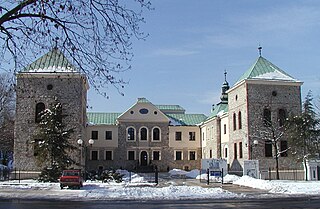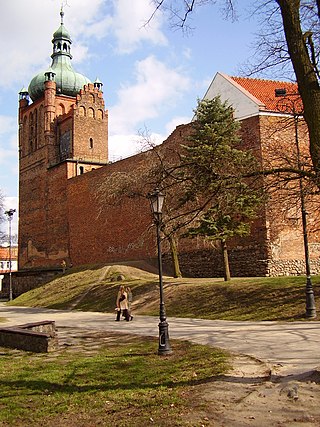
Sielecki Castle is a castle in the city of Sosnowiec in southern Poland, located in the Sielc district. The castle is located on the left bank of the Czarna Przemsza River. It was built in the 17th century and it is the oldest building in the city.

Krzyżtopór is a castle located in the village of Ujazd, Iwaniska commune, Opatów County, Świętokrzyskie Voivodeship, in southern Poland. It was originally built by a Polish nobleman and Voivode of Sandomierz, Krzysztof Ossoliński (1587–1645). The castle was partially destroyed during the Swedish invasion known as The Deluge in 1655, and then reduced to ruins during the war of the Bar Confederation by the Russians in 1770.

Niesytno Castle was a castle in the south-west of Poland, near the village of Płonina, situated west of Bolków. After the castle turned into ruins, Płonina Palace was built at the same site, though the place is still often referred to as Niesytno Castle. It has decayed over the years, and only its ruins have remained. It is in private hands and closed to the public, but is along the tourist Piastowskich Castle Route.

The Sandomierz Royal Castle is a medieval structure in Sandomierz, Poland. It was built on a slope of Vistula River by Casimir III the Great and extended in the 16th century. The original building was blown up in 1656, leaving only the west wing standing. It was later transformed into a Renaissance styled residence with the west wing preserved as a museum.

The Castle of the Masovian Dukes in Płock is a Gothic castle built under the reign of Casimir III the Great, becoming a stronghold of the Dukes of Masovia until the fifteenth century. The castle is located in the Princely Capital City of Płock, Masovian Voivodeship; in Poland.

Uniejów Castle - one of the main places of interest in Uniejów, Łódź Voivodeship; in Poland.

Kwidzyn Castle is a large brick Gothic castle in the town of Kwidzyn, Poland. It is an example of the Teutonic Knights' castle architecture.

Gołuchów Castle is an early Renaissance castle built in 1550-1560 for Rafał Leszczyński on a square plan and used as a defensive stronghold and residence. The castle is located in Gołuchów, Greater Poland Voivodeship, Poland.

Grodno Castle is a castle located in the southern parts of the Wałbrzych Mountains, on the Choina Mountain, standing to the left of the river Bystrzyca. The valley of this river, formerly known as the Silesian Valley, creates a natural boundary between the Owl Mountains and to the west of it the Wałbrzych Mountains. The castle is located in Zagórze Śląskie, Lower Silesian Voivodeship in Poland.

Radzyń Chełmiński Castle is a Brick Gothic monastery-castle completed in 1330 as the seat of the Teutonic Knights' Commandry. It lies near Castle Lake to the north of the town of Radzyń Chełmiński. Three of the four walls and most of the internal buildings of the keep are ruined.

Sobieski's Castle in Oława is a Renaissance-Baroque style castle located in the site of a former Gothic castle. The original castle had been built by Duke Ludwik I built in the second half of the fourteenth century. It was the third castle structure in Oława, the first being the seat of the castellans, located in the south-east of the town. It remained an integral part of the town's defenses until the wars with the Hussites.

The Olsztyn Castle, officially the Castle of Warmian Cathedral Chapter in Olsztyn, is a Brick Gothic castle located in the heart of Olsztyn, in northern Poland. Built in the 14th century, it served as the seat for administrators of property of the Warmian Cathedral Chapter. The most well-known administrator caretaker was Nicolaus Copernicus, a canon of Warmian Cathedral Chapter in Frombork, who resided here between 1516 and 1521. The largest expository room is the refectory with a diamond vault built around 1520. Currently, the castle houses the Museum of the Warmian-Masurian Voivodeship.

Lębork Castle - a castle built by the Teutonic Order located in Lębork, Pomeranian Voivodeship. The building is found on the river Łeba.

Olsztyn Castle – castle ruins located in the Kraków-Częstochowa Upland, lying on the Trail of the Eagles' Nests – formerly protecting the southern border of the Kingdom of Poland. The ruins of the 14th-century castle are one of the biggest attractions of the area.

Ryn Castle is a fourteenth-century castle located between Ryn and Ołów Lake, by Liberty Square in Ryn, Poland.

Czchów Castle - Romanesque castle ruins located in Czchów, located on a hill known as the Keep on the Dunajec in Brzesko County, Lesser Poland Voivodeship in Poland.

Kazimierz Dolny Castle, originating from the thirteenth and fourteenth-century, is a Romanesque castle ruins located in Kazimierz Dolny, Lublin Voivodeship in Poland.

Rabsztyn Castle is a preserved Gothic ruined castle located in the Polish Jura within the Eagles' Nests Trail, in the village of Rabsztyn, Lesser Poland Voivodeship in southern Poland.

Bąkowiec Castle is a fourteenth-century knight's castle ruins, located in the Kraków-Częstochowa Upland. The fortress was built as part of the Trail of the Eagles' Nests defence system, located in the village of Morsko, Silesian Voivodeship in Poland.

The Duchy of Löwenberg or Duchy of Lwówek was one of the Duchies of Silesia and medieval Poland established in 1281 as a division of the Duchy of Jawor. The duchy of Lwówek was ruled by the Silesian Piast, Bernard the Lightsome, with its capital at Lwówek Śląski in Lower Silesia. It was the southwesternmost duchy of Poland at the time.





















